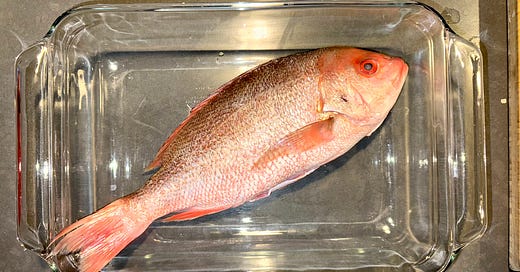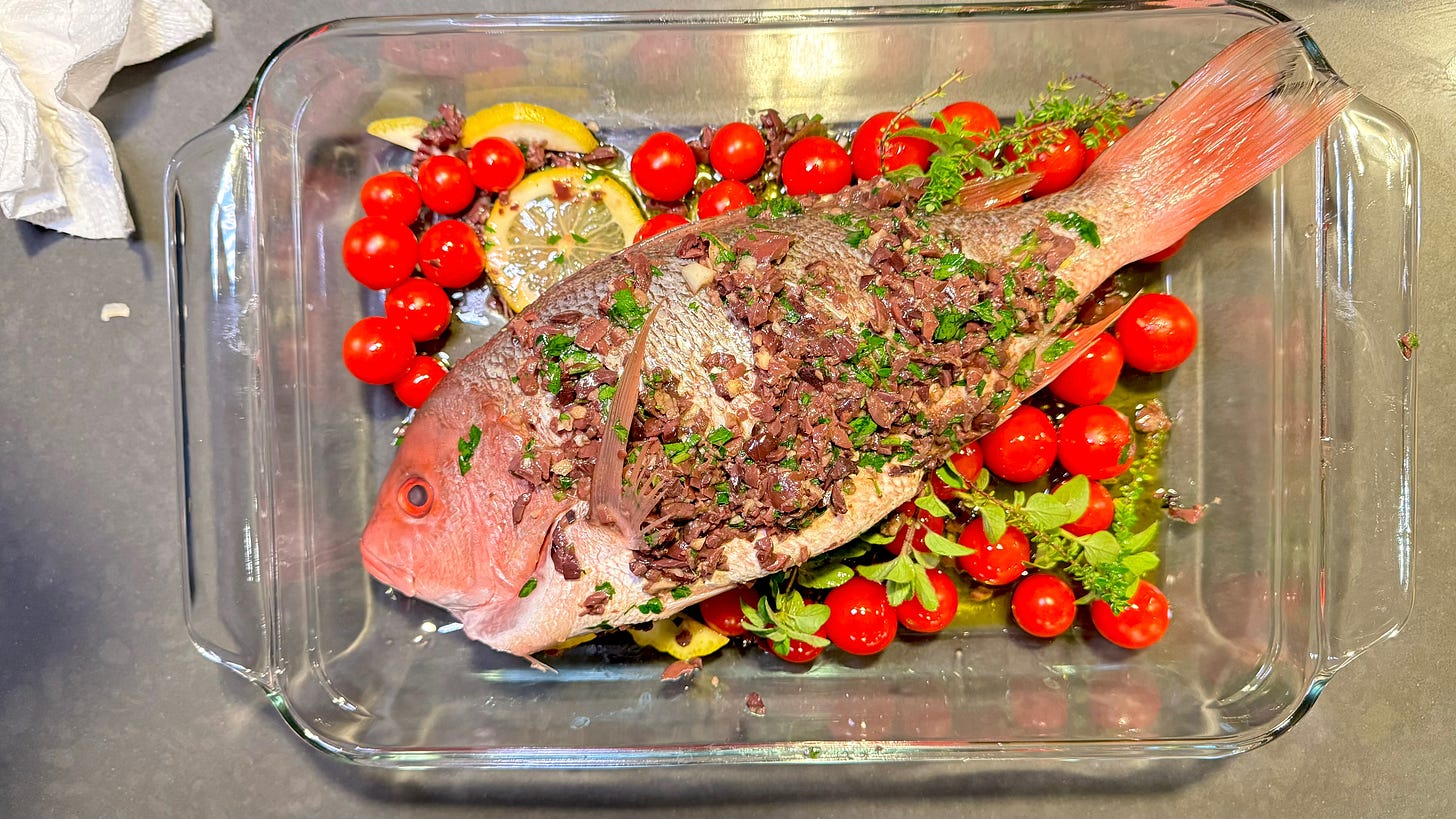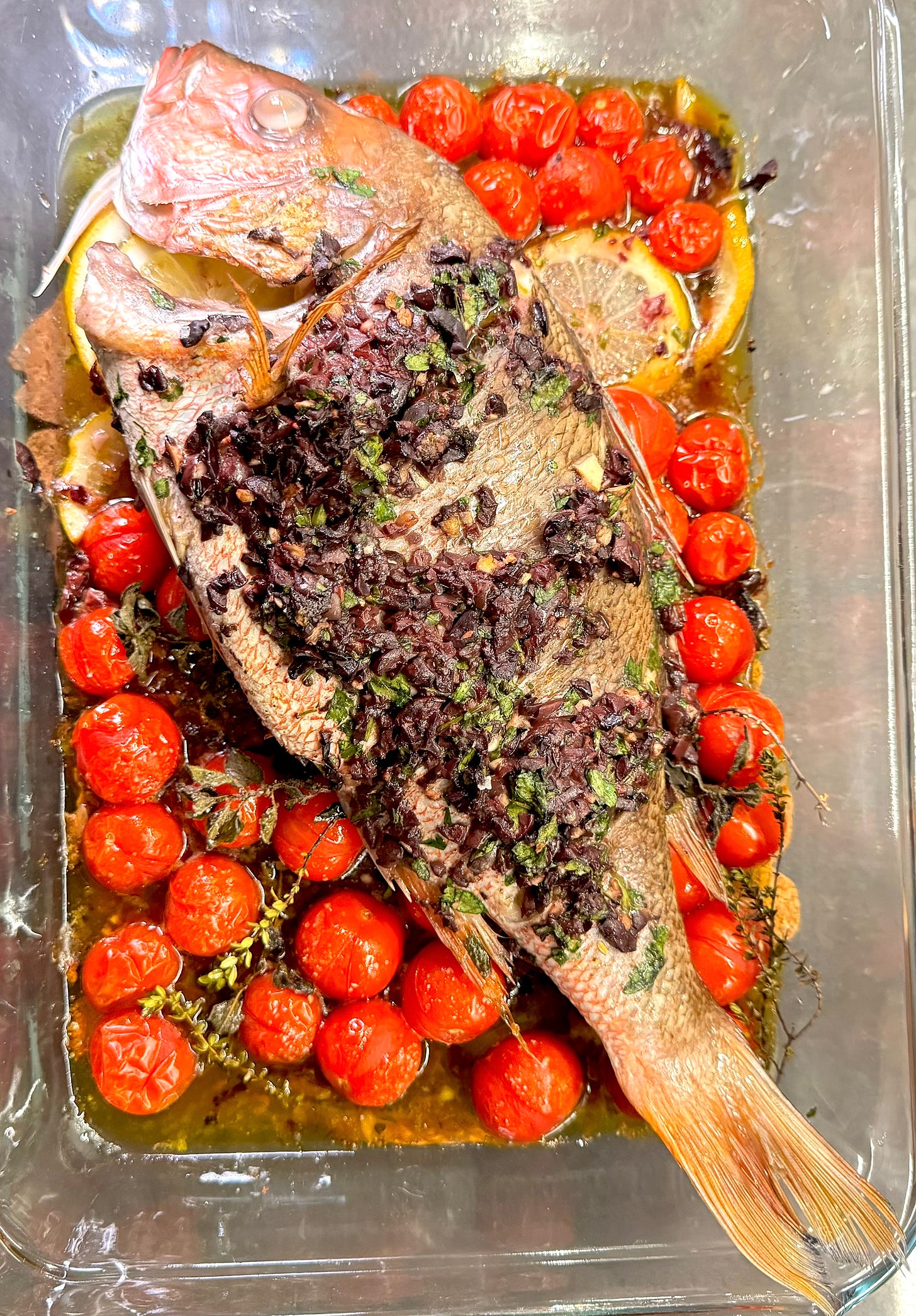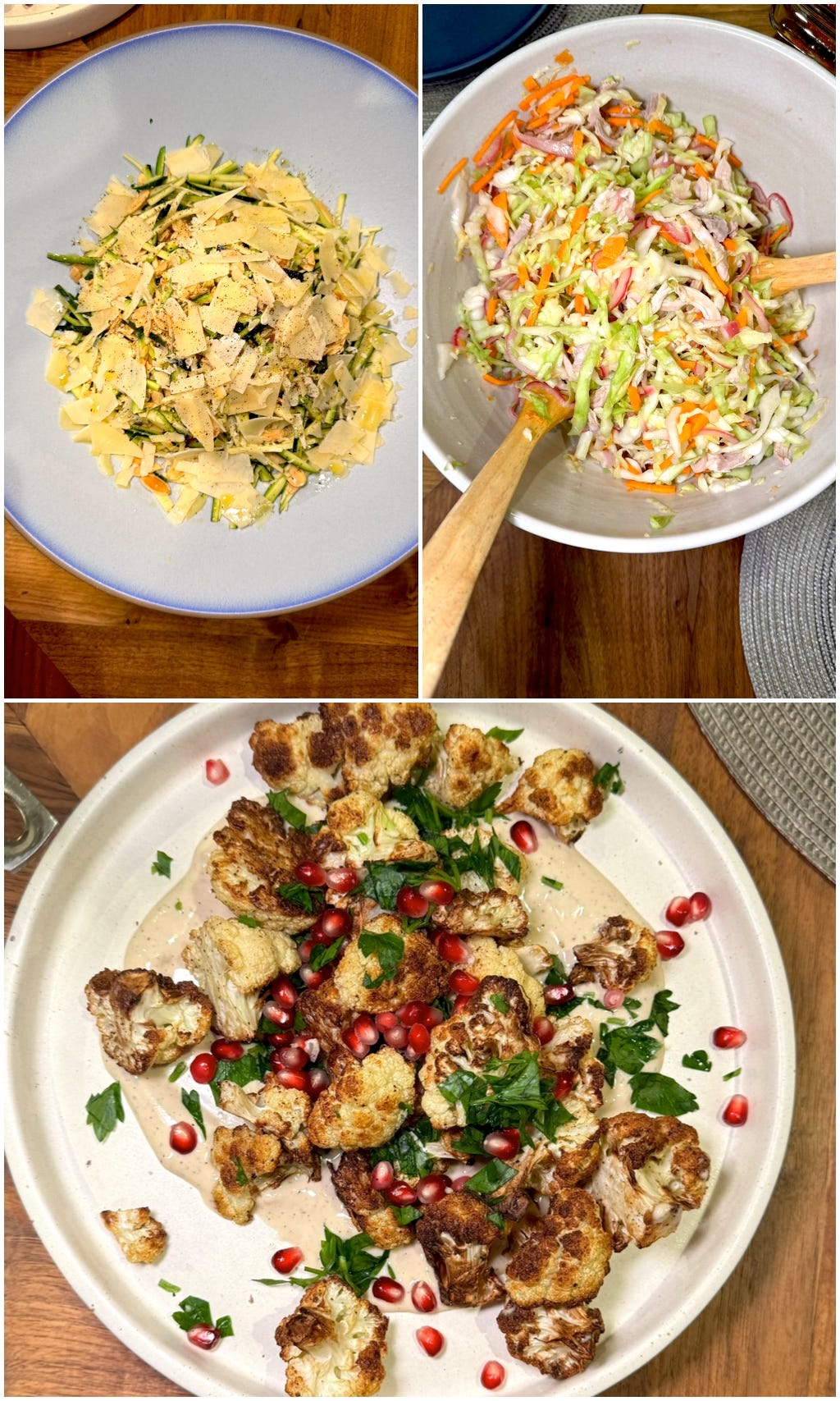Why have I never cooked a whole fish?
It’s an existential question that I ask myself from time to time — usually when I’m very bored. Like, very bored. I think on many levels I’m straight up intimidated by cooking a whole fish. Just picking one from the market seems like an ordeal in and of itself: does the skin have a metallic glow? Does the fish smell normal? Are the eyes clear? Is it happy? Did it live a good life? How many Instagram followers did it have? It’s stressful.
I don’t know why I get in my head about this process. Cooking whole chicken is no less intimidating, but I go in guns blazing all the time. Heck, turkey is so finicky and difficult that there’s an entire hotline dedicated to roasting it.
Yet it’s fish that scares me. Maybe it’s because fish is more expensive, more delicate, more easily squandered. Maybe it’s because to find a whole fish in LA, I usually have to make a dedicated trip to a fishmonger (ew, effort! gross!), and that’s annoying.
Or maybe it’s that whole fish — with their colors and sizes and creepy eyes — seem exotic, which then feels intimidating and unapproachable. Compare it to chicken. Neatly packaged whole birds are everywhere - piling up in the meat section like bowling balls in a queue. They come wrapped in plastic and adorned with brand names like Foster Farms and Perdue. There’s something generic about them - it’s like, if you mess it up, you can just cook another one tomorrow.
Whole fish, on the other hand, have no packaging, no corporate labels, no sense that these fish just came flopping out of a processing facility. In that way whole fish feel unique and special and elevated. It’s scary to tangle with that. (And again, you might find them in your supermarket, but chances are you have to make a special trip to a fish specialist, which somehow raises the stakes on everything.)
In other words, after putting in so much time and money to find a good fish, what if I mess it up?? Better to just not bother in the first place.
And so I just leaf right past recipes for whole fish in my cookbooks. I don’t even see them. They might as well be blank pages. Sure, occasionally there’s a stunning photo, but I don’t ever consider the recipe. What’s even the point?
That’s why I was surprised when the other day, as I was paging through Rick Martínez’s Mi Cocina cookbook, I paused at a recipe for Pescado a la Talla — or grilled red snapper. Something about the vibrantly red, butterflied fish halted me. I could imagine it coming off the grill — tangy and bright and smoky. With the days growing longer and warmer, it would be the perfect dish for a mid-week potluck I had coming up.
It was time… time to cook a whole fish.
But let’s not get too crazy. The idea of grilling my first whole fish was a bit much for me. Grilling is its own thing, and I didn’t need to introduce the chaos of open flame into the situation. So, instead, I bookmarked Martínez’s recipe and pivoted to some other books.
Smashing Plates by Maria Elia is a much lauded modern Greek cookbook that fared particularly well in Food 52’s now defunct Piglet competition (btw someone please bring the Piglet back). It’s also a book that has languished on my shelf for many years with nary a recipe ever being made. Every time I’ve turned to it, I’ve either been short of ingredients or short of motivation. This gave me extreme guilt, especially since the book was a gift from a lovely podcast listener named Tracy. I’d been waiting for the right time to dive into Smashing Plates, and I suspected that if any book might have a compelling whole fish option, it could be this one.
Sure enough, right there on page 74 was a recipe simply titled “Whole Baked Snapper.” I saw garlic, I saw Kalamata olives, I saw cherry tomatoes. I knew this would be the pivot I needed. Plus, to be honest, it looked dead simple.
After having procured a 2 lb red snapper at a nearby fish counter, I set about preparing the dish. First, a stuffing: I chopped up garlic, anchovies, Kalamata olives, and parsley, mixing it all with about two tablespoons of olive oil. This casual tapenade did double duty as a super briney flavor bomb that my friend Sylvia seemed eager to eat like breakfast cereal. I could see her heart break as I contaminated the bowl with my raw fish hands.
I then cut three deep slashes in the fish on both sides and crammed as much olive mixture inside as I could. There was a major olive surplus; so I slathered the rest directly on the fish’s skin.
Lastly there was some light busywork. I stuffed the fish’s cavity with lemons, scattered cherry tomatoes and olive oil in a baking dish, and added some fresh thyme and oregano from my plucky garden box (her name is Gail, for those unaware). I laid the fish atop the tomatoes, seasoned with salt, and shoved the whole thing in my toaster oven — yes, toaster oven — at 375 degrees.
Why a toaster oven? Why not? The baking dish fit, and it’s easier to control than my rageful Bertazzoni oven.
After 31 minutes, the red snapper was ready. There were some initial concerns that 375 degrees might not be hot enough to roast the cherry tomatoes, but I can assure everyone they were wrinkled and bursting with their juices. The fish, meanwhile, had turned opaque, and offered no resistance when punctured with a toothpick. According to Elia, this meant the red snapper was ready for showtime.
I brought the fish out to the table where it lorded over a divine spread of other potluck offerings: Vietnamese cabbage salad from Sylvia, zucchini and almonds and parm from my friend Judy, and some impromptu air fryer cauliflower I tossed together while the fish was roasting. Not bad for an easygoing Wednesday night. (And, lest I leave her out, my friend Derya supplied a fantastic lemon olive oil cake for dessert.)
All the food looked (and turned out to be) delicious. But it was the mighty red snapper that captivated all of our attention. How would this untested recipe from an untested book with an untested ingredient turn out? Would it be a colossal failure?Would it be a one-and-done? And would I choke on a fish bone?
After a very helpful filleting tutorial from Judy, we all dug into the fish and nearly lost our minds. It was so incredibly good. Like, perfect. Perfectly juicy, perfectly seasoned, perfectly flavorful. Dare I say it was outrageous? The salty, brininess of the olives and anchovies paired beautifully with the sharp acidity of the tomatoes, but it was the fish that truly shone. Everything seemed to melt together into one glorious bite.
And for the record, this red snapper was wildly easy! Easier than most chickens I’ve made and definitely faster. Why was I so scared?
This was a thrilling dish. Thrilling because it tasted so excellent, thrilling because it was so fast and foolproof, and thrilling because it meant that whole swaths of recipes in my cookbook library were now viable options to me. Achievement unlocked, as they say.
My only regrets? I forgot to sprinkle dill over the fish (didn’t even need it), and I didn’t have any crusty bread on hand to soak up the juices. We all survived. And now I know for next time (because there WILL be a next time).
I’m not sure if I’m ready to grill a whole fish next, but I’m feeling adventurous these days; so you never know…
Have you cooked whole fish? What have been your favorite recipes and tips?








Way to face your whole-fish fears, Ben! I don’t even like to cook shrimp with the shells on so this is inspiring!
It looks beautiful! I grew up in Rhode Island, and now that I think of it, my parents were pretty comfortable cooking whole fish or fileting a full raw fish. It's not a skill they passed down to me, though. Now I'm thinking i might try it.
Sandy would ask why you didn't cook branzino:-)